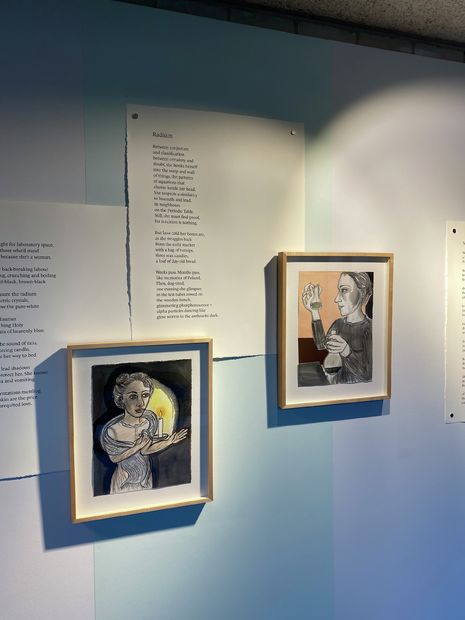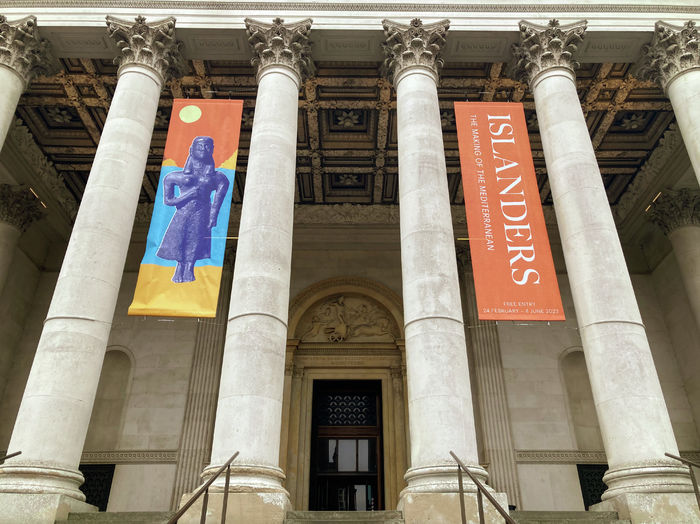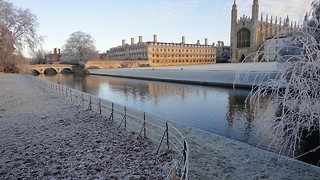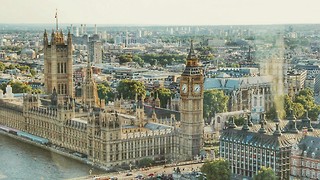Radium Dreams: illuminating the life of a female scientist?
Miranda Lepri reflects on a fusing of poetry and paintings which aims to light up Marie Curie as a feminist icon – but is slightly more of a cringe than a chemical reaction

My leg is cramping, twisted underneath me. The evening sun drifts through the window, drawing my attention, and when I peek over at the notebook of the girl next to me who has been writing diligently, instead of notes, I see a sketch of the view outside. We are all restless, it seems, on this warm summer night.
This is “Radium Dreams”, an event hosted by the university’s poetry society, “The Cambridge Blackbirds.” Organised around the eponymous exhibit at The Women’s Art Collection in Murray Edwards College, the name evokes fluorescent surrealism - which is somewhat at odds with the narrow, linoleum-floored hallway in which I find myself that evening, listening to art critic, poet, and novelist (chronologically in that order) Sue Hubbard read aloud from her poetic biography of famous Polish chemist and physicist Marie Curie. With her bright red lipstick, and her face haloed in frizzy brown hair, Sue reminds me of the women in the Eileen Cooper paintings which accompany her poems throughout the exhibit.
“Marie Curie, a scientist, represents a foray into the unknown for her”
This is not Hubbard’s first biographical work, but her third - her previous subjects are German expressionist painter Paula Modersohn-Becker (“Girl in White”) and Welsh Post-Impressionist Gwen John (“Everything Begins with the Skin”) - but this one, Sue says, is different to her. Her previous biographical writings explore the lives of female painters, a subject well within her area of authorial expertise. Marie Curie, a scientist, represents a foray into the unknown for her, and she admits to us with a hint of self-deprecation that she knows very little about chemistry or physics. Still, she says, while she may not connect to Curie as a fellow scientist, her interest lies in the internal lives of women of Curie’s period, just beginning to break out of the constraints of bourgeois life at the turn of the century.
Despite their differing origins, all three of her subjects came to Paris, living there at a time when it represented a centre of culture and place of opportunity for women across Western Europe. Nevertheless, I can’t help but stifle a giggle when Hubbard speaks about wanting to bring credit and appreciation to Marie Curie - the subject of so many Year 8 girls’ science presentations.
Harriet Loffler, the Women’s Art Collection’s curator, tells us that Marie Curie’s life embodies the aim of the collection: women uplifting one another. She reveals that Curie made a deal with her sister, who went ahead to Paris to pursue a medical education, financially supported by Marie’s work as a governess - so when Marie finally joined her sister, she was in turn supported in her research. While the sentiment is a little trite (how many times have we all been told that feminism is women supporting women) the story is sweet, nonetheless.
“Cooper’s paintings are eerie, populated by the faces of melancholy women”
Rather than Cooper’s paintings illustrating Hubbard’s poetry, Hubbard instead describes a “dialogue” between the two mediums - one which the two artists struggled to find, as Hubbard tells us of the many iterations the collection went through, the many failed attempts at artistic harmony. Cooper’s paintings are eerie, populated by the faces of melancholy women, rendered in muted browns, blues, greys; their plaintive gazes seem to follow me down the hall. They are striking, certainly, but beside the carbon black and fluorescent green descriptions of Hubbard’s poems, Cooper’s work feels disconnected, in style as well as colour - Hubbard’s poems are blunt, straightforward, while Cooper’s paintings are more recessive.
I consider the poem “Ladder,” which recounts Marie’s work as a governess, waiting for her sister to finish her studies. There is no description explaining this, nor is one needed, as the opening lines read, “She longs to study/ but takes work/ as a governess/ with a family of lawyers/ who don’t pay their bills,/ to support her sister/ train as a doctor.” The accompanying artwork depicts two grey-toned women, both clad in blue knee-length dresses, reaching towards each other’s faces: one from above, perched on a titular ladder, one from below on the floor. I can’t help but cringe at the clumsy attempt at so-called “dialogue.”
Hubbard has critical acclaim - she certainly doesn’t need my approval. But I do think, reading these vague descriptions of glowing test tubes and equations scribbled on pages, that perhaps she has strayed too far from her niche with “Radium Dreams,” a collection that should inspire luminous imagery, but instead is drawn in shades of grey.
 Comment / Anti-trans societies won’t make women safer14 November 2025
Comment / Anti-trans societies won’t make women safer14 November 2025 News / Controversial women’s society receives over £13,000 in donations14 November 2025
News / Controversial women’s society receives over £13,000 in donations14 November 2025 News / John’s rakes in £110k in movie moolah14 November 2025
News / John’s rakes in £110k in movie moolah14 November 2025 Fashion / You smell really boring 13 November 2025
Fashion / You smell really boring 13 November 2025 Music / Three underated evensongs you need to visit14 November 2025
Music / Three underated evensongs you need to visit14 November 2025










